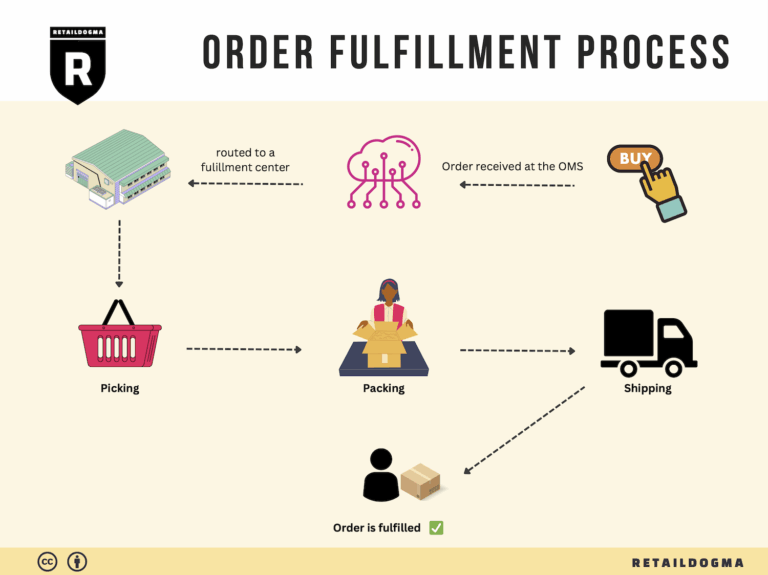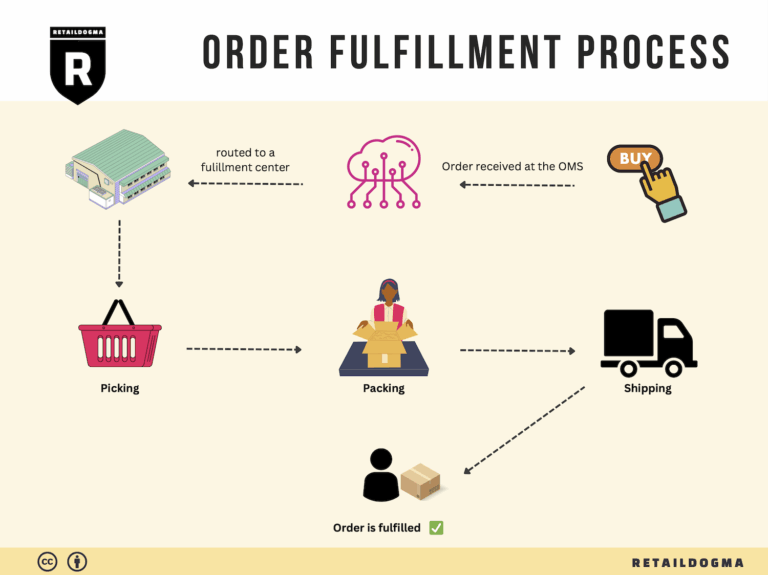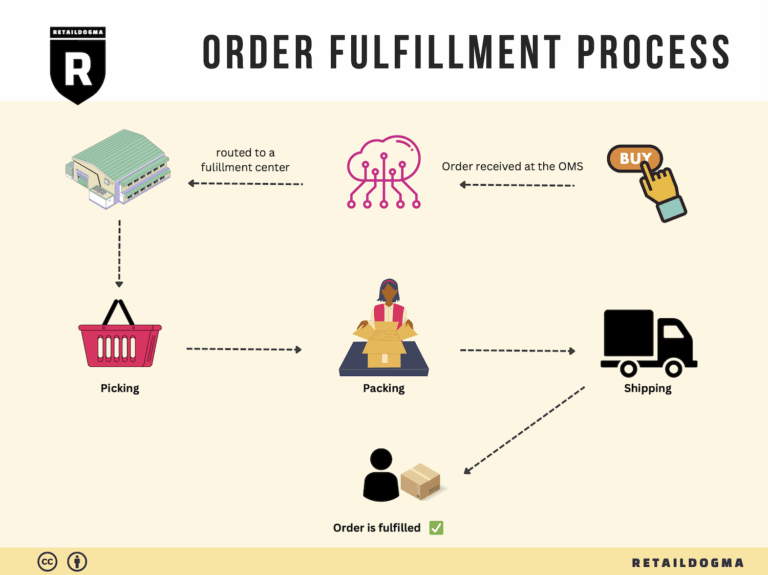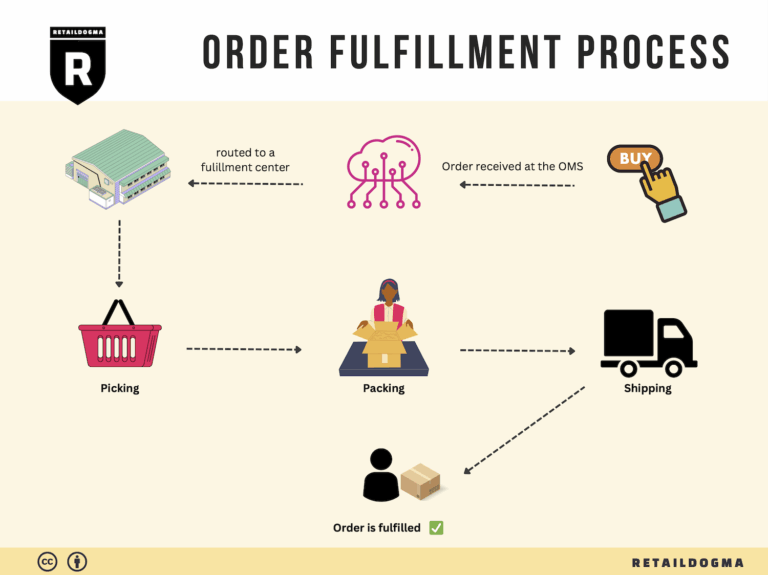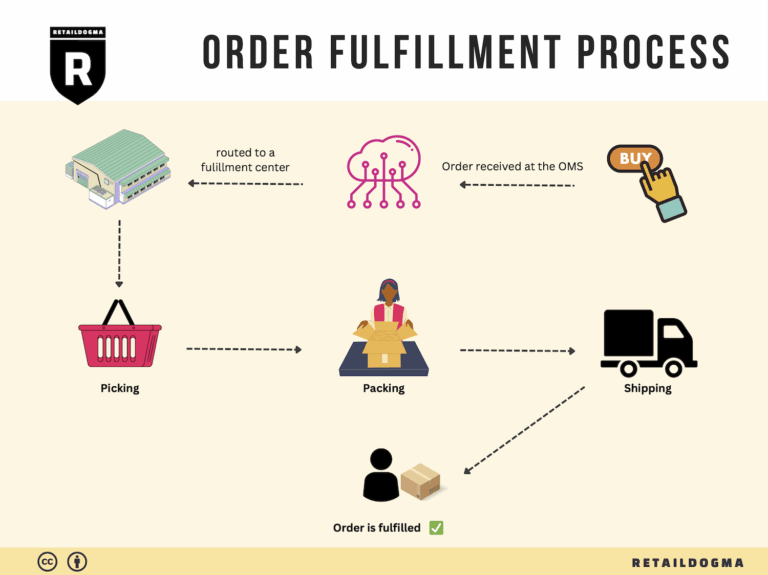Ecommerce Fulfillment Services: The Ultimate Guide (2025)
What is E-commerce Fulfillment? An Introduction for Growing Businesses
Understanding E-commerce Fulfillment: A Vital Component for Growth
As e-commerce businesses expand, many entrepreneurs find themselves grappling with the complexities of packing and shipping orders. This often leads to overwhelm, as managing logistics can quickly become a daunting task that distracts from core business activities such as marketing and customer engagement. However, fulfillment is a critical process that directly impacts customer satisfaction and retention. In simple terms, fulfillment is the series of steps involved in getting a product from your warehouse or fulfillment center to the customer’s doorstep.
This guide aims to demystify the fulfillment process for growing businesses by providing a comprehensive overview of the various models available, including Third-Party Logistics (3PL) and Fulfillment by Amazon (FBA). Understanding these models will help you make informed decisions about how to handle your logistics efficiently.
Key Components of Fulfillment
Fulfillment encompasses several core services, including inventory management, order processing, packing, shipping, and returns handling. Each of these components plays a vital role in ensuring that customers receive their orders promptly and in excellent condition. For instance, effective inventory management is crucial for avoiding stockouts and ensuring timely order fulfillment, while efficient packing and shipping can significantly enhance the customer experience.
Choosing the Right Fulfillment Partner
Selecting a fulfillment partner is a critical step in scaling your business. Factors to consider include the partner’s location, technology capabilities, scalability, and the range of services they offer. A suitable partner can provide not just logistics support, but also valuable insights into improving operational efficiency and customer satisfaction.
Pricing Considerations
Understanding the pricing structure of your fulfillment partner is essential for maintaining profitability. Costs can vary widely based on factors such as order volume, storage fees, and shipping rates. This guide will help you navigate these complexities and provide tips on how to negotiate favorable terms with your chosen partner.
Empowering Your Business Decisions
Ultimately, the goal of this guide is to empower e-commerce business owners and operations managers to make informed decisions regarding their logistics strategy. By understanding the nuances of e-commerce fulfillment, you can streamline your operations, enhance customer satisfaction, and position your business for sustained growth. Whether you are just starting or looking to optimize your current fulfillment process, the insights provided here will serve as a valuable resource in your journey towards operational excellence.
What You’ll Learn In This Guide
- What is E-commerce Fulfillment? An Introduction for Growing Businesses
- The Order Fulfillment Process: From ‘Buy’ Button to Customer’s Door
- Comparing Fulfillment Models: In-House vs. 3PL vs. Dropshipping
- A Deep Dive into Amazon FBA: Pros, Cons, and Who It’s For
- Core Services Offered by Fulfillment Centers
- How to Choose a Fulfillment Partner: A 6-Point Checklist
- Understanding Fulfillment Pricing: A Breakdown of Common Fees
- Frequently Asked Questions (FAQs) about Fulfillment
- Conclusion: Is Outsourcing Fulfillment the Right Move for Your Business?
- Important Disclaimer
The Order Fulfillment Process: From ‘Buy’ Button to Customer’s Door
1. Receiving Inventory
The first step in the order fulfillment process is receiving inventory at the fulfillment center. When products arrive, they are checked against the purchase orders to ensure accuracy. This process involves verifying quantities, inspecting for damages, and confirming that the correct items have been delivered. Each item is assigned a Stock Keeping Unit (SKU), which is a unique identifier that helps track inventory levels and locations throughout the warehouse.
This step is crucial because it lays the foundation for effective inventory management. Accurate receiving helps prevent stock discrepancies and ensures that customers receive the correct products. Any errors at this stage can lead to fulfillment issues later on, impacting customer satisfaction and operational efficiency.
2. Warehouse Storage
Once inventory is received and verified, the next step is warehouse storage. Products are organized and stored in designated locations within the fulfillment center based on various factors such as size, type, and demand. Efficient storage strategies, such as utilizing shelving systems and automated storage solutions, can significantly enhance the speed of order processing.
Proper warehouse storage is vital for optimizing space and ensuring quick retrieval of items during the picking phase. Utilizing a well-organized system minimizes the time spent searching for products, thus improving overall order fulfillment efficiency. Key terms associated with this step include “slotting,” which refers to the strategic placement of products to maximize picking efficiency.
3. Order Picking
Order picking is the process where items are retrieved from storage to fulfill customer orders. This step can be executed using various methods, such as single order picking, batch picking, or zone picking, depending on the fulfillment center’s operational strategy. Pick lists, which detail the items and quantities needed for each order, guide warehouse staff in this process.
Efficient order picking is crucial for maintaining fast order turnaround times. The accuracy of this step directly affects customer satisfaction—incorrect picks can lead to returns, exchanges, and negative reviews. Implementing technologies such as barcode scanning and pick-to-light systems can streamline this process, reduce errors, and enhance productivity.
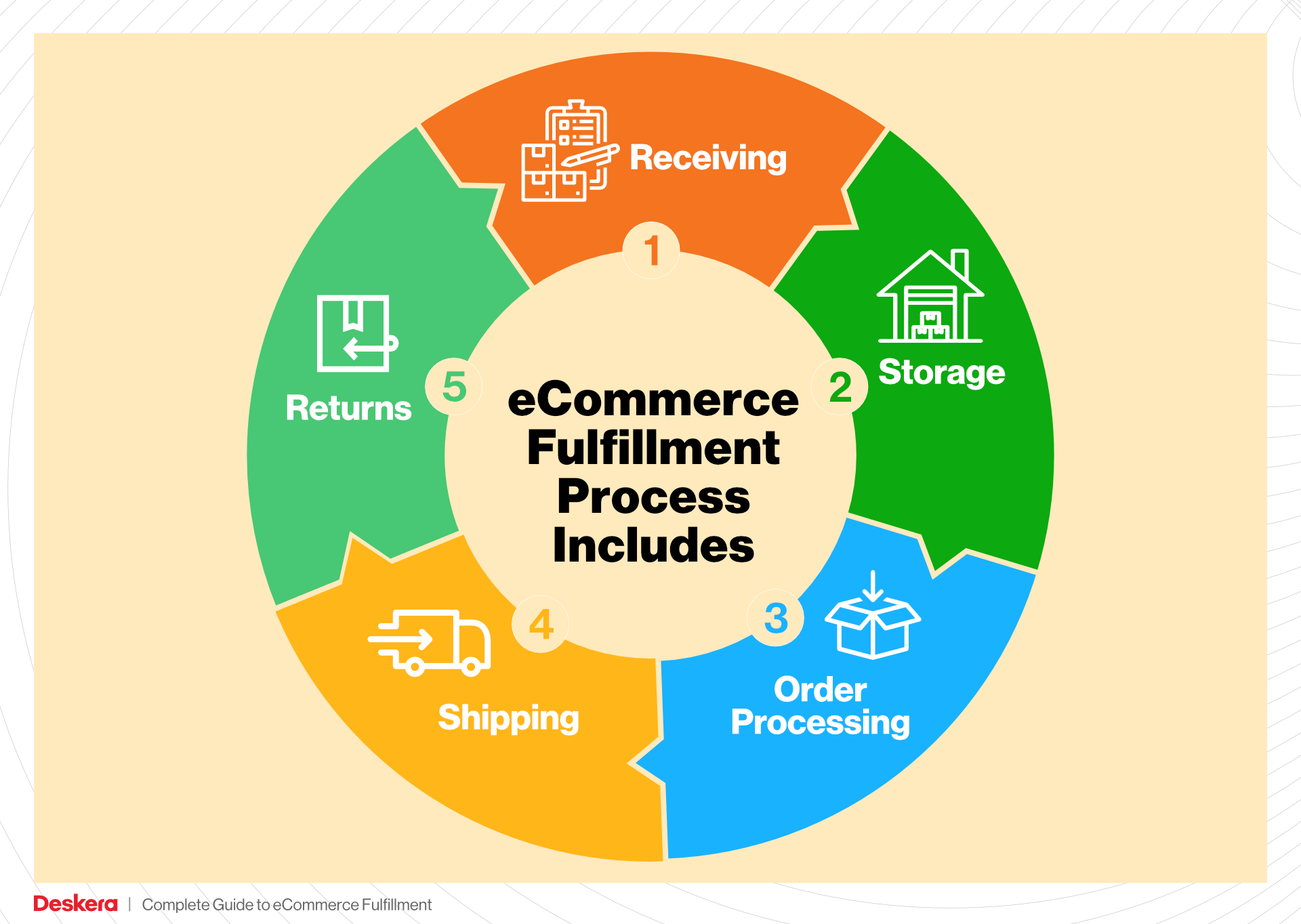
4. Order Packing
After items are picked, they move to the packing stage. Here, products are carefully packaged for shipment. This includes choosing the appropriate packaging materials, such as boxes or padded envelopes, and ensuring that items are securely packed to prevent damage during transit. Packing slips and invoices are also included in the package to provide customers with necessary information.
The packing process is essential not only for protecting the items but also for branding and customer experience. Thoughtful packaging can enhance the unboxing experience, encouraging repeat business. A key term associated with this step is “dimensional weight,” which influences shipping costs based on package size rather than just weight, making it crucial to optimize packing methods.
5. Shipping & Delivery
The final step in the order fulfillment process is shipping and delivery. Once packages are packed, they are labeled and prepared for dispatch. Fulfillment centers often collaborate with various carriers to determine the most efficient and cost-effective shipping options. Tracking systems are employed to monitor packages throughout the delivery process.
This step is critical as it represents the culmination of the fulfillment journey. Timely and accurate delivery is paramount for customer satisfaction. Delays or issues at this stage can result in unhappy customers and lost sales. The use of key performance indicators (KPIs) such as on-time delivery rates and shipping accuracy can help businesses evaluate their performance and make necessary adjustments to improve their logistics strategies.
By understanding and optimizing each step of the order fulfillment process, e-commerce businesses can enhance their operational efficiency, reduce costs, and ultimately provide a superior experience to their customers.
Comparing Fulfillment Models: In-House vs. 3PL vs. Dropshipping
Fulfillment Model Comparison
| Model | Who Handles Inventory | Best For (Business Stage) | Key Advantage | Key Disadvantage |
|---|---|---|---|---|
| In-House Fulfillment | Business owns and manages | Established businesses | Full control over operations and inventory | High overhead costs and management complexity |
| Third-Party Logistics (3PL) | 3PL provider manages | Growing businesses | Scalability and access to expertise | Less control over logistics and potential misalignment with business goals |
| Dropshipping | Supplier/manufacturer ships | Startups and small businesses | Low upfront investment and minimal risk | Lower profit margins and reliance on suppliers for inventory quality and shipping speed |
In-House Fulfillment
In-house fulfillment is a model where a business manages its own inventory, warehousing, and shipping processes. This approach is often favored by established businesses that have the resources to invest in their logistics operations. One of the key advantages of in-house fulfillment is the level of control it offers. Businesses can dictate how their products are stored, packaged, and shipped, which can lead to a more personalized customer experience. Moreover, having direct oversight allows for faster decision-making and adjustments to logistics strategies in response to market demands.
However, this model comes with significant challenges. The overhead costs associated with maintaining a warehouse, hiring staff, and managing the logistics infrastructure can be substantial. Additionally, as businesses scale, the complexity of operations increases, requiring sophisticated management systems and processes to ensure efficiency. For many companies, especially those just starting out, the resources needed to implement in-house fulfillment can be a barrier to entry.
Third-Party Logistics (3PL)
Third-party logistics (3PL) providers are external companies that manage logistics and fulfillment operations on behalf of businesses. This model is particularly advantageous for growing businesses that need to scale their operations without the burden of managing their own warehousing and distribution. By partnering with a 3PL, businesses can leverage the provider’s expertise, infrastructure, and technology, allowing them to focus on their core competencies like marketing and product development.
One of the primary benefits of using a 3PL is scalability. As order volumes fluctuate, businesses can easily adjust their logistics needs without having to invest in additional resources or infrastructure. Moreover, 3PL providers often have advanced logistics technology that can enhance supply chain visibility and efficiency. However, the trade-off is a potential loss of control over the fulfillment process. Businesses must rely on their 3PL partner to meet service level agreements, and any misalignment in goals or operations can lead to customer dissatisfaction. Additionally, businesses may face challenges with integration and communication with their 3PL, which can complicate order management.
Dropshipping
Dropshipping is a fulfillment model where a business sells products without holding inventory. Instead, when a product is sold, the order is forwarded to a supplier who then ships the product directly to the customer. This model is particularly popular among startups and small businesses due to its low upfront investment and minimal risk. Entrepreneurs can launch an online store without the need for significant capital to purchase inventory, making it an attractive option for those testing the waters of e-commerce.
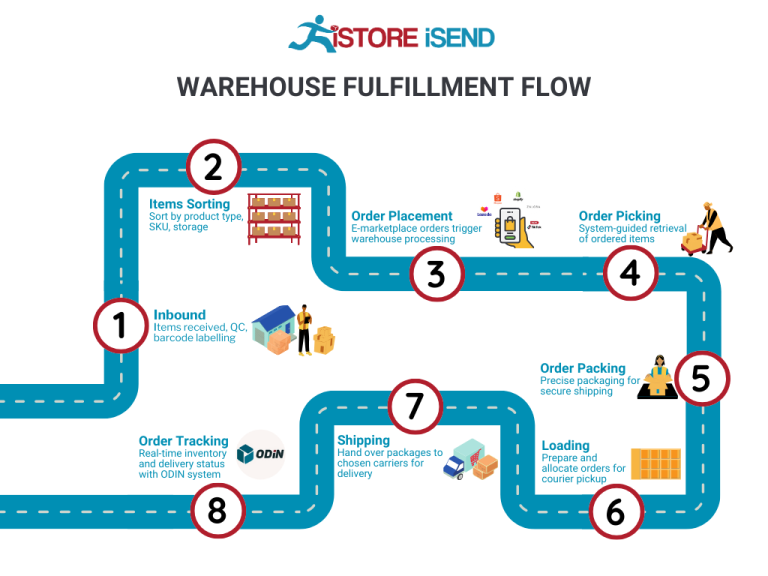
Despite its advantages, dropshipping comes with its own set of challenges. One of the major drawbacks is the lower profit margins typically associated with this model. Since businesses are reliant on suppliers for inventory and fulfillment, they often have to mark up prices to maintain profitability. Additionally, the quality of the customer experience can be inconsistent, as businesses have little control over shipping times and product quality. Delays and issues with suppliers can damage a brand’s reputation, making it crucial for businesses to choose reliable partners. Furthermore, as the market becomes increasingly competitive, differentiating oneself from others using the same dropshipping suppliers can be a challenge.
Conclusion
Choosing the right fulfillment model is essential for e-commerce businesses looking to scale. Each model—whether in-house fulfillment, third-party logistics, or dropshipping—has its unique advantages and disadvantages. Businesses must carefully evaluate their current stage, resources, and long-term goals to determine which fulfillment strategy aligns best with their operational needs and customer expectations. By understanding the nuances of each model, entrepreneurs can make informed decisions that enhance their logistics efficiency and support their growth objectives.
A Deep Dive into Amazon FBA: Pros, Cons, and Who It’s For
Understanding Fulfillment by Amazon (FBA)
Fulfillment by Amazon (FBA) is a service that allows e-commerce sellers to store their products in Amazon’s fulfillment centers, where Amazon takes care of storage, packaging, and shipping. When a customer places an order, Amazon picks, packs, and ships the product directly to the customer on behalf of the seller. This service not only streamlines logistics but also enhances the seller’s visibility on the Amazon platform.
How FBA Works
- Account Setup: Sellers start by creating an Amazon seller account and enrolling in the FBA program.
- Product Listing: Sellers list their products on Amazon, indicating which items will be fulfilled through FBA.
- Inventory Shipment: Sellers send their products to Amazon’s fulfillment centers. Amazon provides guidelines on how to prepare and package items for shipment.
- Storage: Once the products arrive at the fulfillment center, they are stored until sold.
- Order Processing: When a customer orders a product, Amazon handles the entire fulfillment process, including picking, packing, and shipping.
- Customer Service: Amazon also manages customer service and returns for FBA orders, allowing sellers to focus on other aspects of their business.
Pros of FBA
-
Prime Eligibility: One of the most significant advantages of using FBA is the eligibility for Amazon Prime. Products fulfilled by Amazon are often Prime-eligible, which can lead to increased sales due to the appeal of fast, free shipping to Prime members.
-
Enhanced Customer Trust: Leveraging Amazon’s brand recognition and reliability can enhance customer trust. Buyers often feel more confident purchasing items fulfilled by Amazon, knowing they will receive quality service and support.
-
Multi-Channel Fulfillment: FBA allows sellers to fulfill orders from multiple sales channels, not just Amazon. This means that sellers can use FBA for their own websites or other e-commerce platforms, creating a streamlined logistics process.
-
Efficient Logistics and Operations: Amazon’s extensive logistics network allows for efficient storage and shipping. Sellers can benefit from Amazon’s advanced technology and infrastructure, leading to faster delivery times and reduced operational burdens.
-
Automated Customer Service: Amazon handles customer inquiries and returns for FBA orders, freeing up sellers from these often time-consuming tasks.
Cons of FBA
-
High Fees: FBA comes with various fees, including storage fees for holding inventory and fulfillment fees for picking, packing, and shipping items. These costs can add up, particularly for sellers with lower-margin products.
-
Strict Inventory Rules: Amazon has specific guidelines regarding inventory management, including limitations on the number of units that can be stored at fulfillment centers. Sellers must also adhere to strict packaging and labeling requirements, which can create challenges for some businesses.
-
Commingling Risks: FBA has a policy of commingling inventory, which means that products from different sellers can be stored together. This can pose risks for sellers, such as receiving returns that do not belong to them or issues with counterfeit products, which can affect a seller’s reputation.
-
Loss of Control: By using FBA, sellers relinquish some control over their fulfillment process. This can be a concern for businesses that prefer to manage their logistics in-house to ensure quality and consistency.
-
Potential for Inventory Shortages: During peak seasons, such as holidays, fulfillment centers can reach capacity limits. Sellers may face challenges restocking inventory in a timely manner, which can lead to lost sales opportunities.
Who is FBA Best For?
Fulfillment by Amazon is an excellent option for various types of sellers, particularly:
-
New Sellers: Entrepreneurs just starting in e-commerce can benefit from FBA’s streamlined logistics, allowing them to focus on marketing and sales rather than inventory management.
-
Small to Medium-Sized Businesses: Companies looking to scale quickly without investing heavily in their logistics infrastructure can leverage FBA to expand their reach and improve customer service.
-
Product Categories with High Demand: Sellers with products that have high turnover rates can benefit from FBA, as the increased visibility and Prime eligibility can lead to higher sales volumes.
-
Businesses with Limited Resources: Companies that lack the resources to manage shipping, storage, and customer service can find FBA to be a cost-effective solution.
-
Multi-Channel Sellers: Businesses that sell on multiple platforms can streamline their operations by using FBA for fulfillment across various channels, enhancing efficiency and customer satisfaction.
In conclusion, Fulfillment by Amazon offers a powerful tool for e-commerce sellers looking to optimize their logistics and expand their market reach. While it comes with challenges, understanding the pros and cons can help sellers make informed decisions about whether FBA aligns with their business goals and operational capabilities.
Core Services Offered by Fulfillment Centers
Inventory Management & Warehousing
Inventory management and warehousing are foundational services provided by fulfillment centers. This involves the systematic control of stock levels, ensuring that products are stored efficiently and are readily available for order fulfillment. Fulfillment centers utilize sophisticated inventory management systems that track stock quantities, monitor product conditions, and predict inventory needs based on sales trends.
Benefits to E-commerce Businesses:
-
Optimized Stock Levels: By accurately tracking inventory, businesses can avoid overstocking or stockouts, which can lead to lost sales or increased holding costs.
-
Improved Cash Flow: Efficient inventory management ensures that capital is not tied up in excess inventory, allowing e-commerce businesses to allocate funds to other growth areas.
-
Quick Access to Products: Centralized warehousing allows for faster retrieval of products, which is crucial for meeting customer expectations for prompt delivery, especially in a competitive landscape.
Pick and Pack Services
Pick and pack services refer to the process of selecting products from inventory (picking) and preparing them for shipment (packing). Fulfillment centers employ trained staff and automated systems to streamline this process, ensuring accuracy and efficiency. This often includes labeling, packing items in appropriate boxes, and preparing shipping documentation.
Benefits to E-commerce Businesses:
-
Increased Efficiency: Streamlined pick and pack operations reduce the time taken to fulfill orders, allowing businesses to process more orders in less time.
-
Accuracy in Fulfillment: With advanced technology and trained personnel, the likelihood of errors during the picking and packing process is minimized, which enhances customer satisfaction and reduces return rates.
-
Scalability: As order volumes grow, fulfillment centers can easily scale their pick and pack services to meet demand, providing businesses with the flexibility to grow without the burden of managing logistics in-house.
Kitting and Assembly
Kitting and assembly services involve combining multiple products into a single package or preparing items for sale by assembling components. This is particularly beneficial for businesses offering product bundles, promotional kits, or customized orders. Fulfillment centers can handle the kitting process efficiently, ensuring that all components are included and properly assembled.
Benefits to E-commerce Businesses:
-
Enhanced Product Offering: Kitting allows businesses to create unique product bundles, enhancing the value proposition and potentially increasing average order value.
-
Time Savings: Outsourcing kitting and assembly to fulfillment centers saves businesses significant time and labor costs, allowing them to focus on core activities such as marketing and customer service.
-
Quality Control: Fulfillment centers typically have quality control measures in place to ensure that all kits are assembled correctly, reducing the risk of customer dissatisfaction.
Returns Management (Reverse Logistics)
Returns management, or reverse logistics, is the process of handling product returns from customers. Fulfillment centers play a crucial role in this service by managing returned goods, assessing their condition, restocking items, and processing refunds or exchanges. This service is essential as returns are a common aspect of e-commerce, particularly in sectors like apparel and electronics.
Benefits to E-commerce Businesses:
-
Streamlined Return Process: Efficient returns management minimizes the time and resources spent on processing returns, making it easier for customers to return items and enhancing their overall experience.
-
Cost Efficiency: By outsourcing returns management, businesses can reduce overhead costs associated with handling returns in-house, such as labor and storage.
-
Data Insights: Fulfillment centers can provide valuable data on return reasons, helping businesses understand customer preferences and improve product offerings or marketing strategies.
Conclusion
The core services offered by fulfillment centers—inventory management and warehousing, pick and pack services, kitting and assembly, and returns management—are vital for e-commerce businesses aiming to scale effectively. By leveraging these services, businesses can enhance efficiency, improve customer satisfaction, and focus on strategic growth initiatives. In today’s fast-paced e-commerce environment, partnering with a reliable fulfillment center can be a game-changer, providing the necessary infrastructure and expertise to meet customer demands and drive sales.
How to Choose a Fulfillment Partner: A 6-Point Checklist
Location & Warehouse Network
The geographic location of your fulfillment partner can significantly impact shipping times, costs, and overall customer satisfaction. Having warehouses strategically placed near major customer bases can enhance delivery speed and reduce transportation expenses.
Questions to Ask:
– Where are your warehouses located? How does this align with my target market?
– What is the average delivery time from your facilities to my customers?
– Do you have a network of warehouses that can support multi-channel fulfillment?
Technology & Integrations
In today’s fast-paced e-commerce environment, technology plays a crucial role in streamlining operations and ensuring accuracy. A fulfillment partner should have robust systems in place for inventory management, order processing, and real-time tracking.
Questions to Ask:
– What fulfillment software do you use, and how does it integrate with my existing e-commerce platform?
– Can I access real-time inventory data, and how frequently is it updated?
– What tools do you provide for tracking shipments and managing returns?
Specializations (e.g., Cold Storage, Oversized Items)
Different products require different handling and storage capabilities. If your business involves specialized items—such as perishable goods, hazardous materials, or oversized items—it’s essential to choose a partner with the right expertise and facilities.
Questions to Ask:
– What types of products do you specialize in handling? Do you have temperature-controlled storage if I need it?
– Are you equipped to manage oversized or bulky items, and what are the associated costs?
– What procedures do you have in place for handling fragile or high-value items?
Scalability & Capacity
As your business grows, your fulfillment needs may change. It’s vital to select a partner that can scale operations to match your growth without compromising service quality.
Questions to Ask:
– How do you handle seasonal fluctuations in order volume?
– What is your capacity for scaling operations, and how quickly can you ramp up services?
– Do you have a history of supporting businesses through rapid growth phases?
Pricing and Contracts
Understanding the pricing structure and contract terms is crucial for maintaining profitability. Look for transparency and flexibility in pricing to avoid unexpected costs that can eat into your margins.
Questions to Ask:
– Can you provide a detailed breakdown of your pricing structure, including any hidden fees?
– What is your policy on minimum order quantities and storage fees?
– How flexible are your contract terms? Are there penalties for early termination?
Customer Support & Reviews
Exceptional customer support can make a significant difference in your overall experience with a fulfillment partner. Additionally, researching reviews and testimonials can provide insights into their reliability and service quality.
Questions to Ask:
– What level of support can I expect, and how can I reach your team if issues arise?
– Do you offer dedicated account management, and what does that entail?
– Can you provide references or case studies from similar businesses in my industry?
Conclusion
Choosing the right fulfillment partner is a critical decision that can affect your e-commerce operations and customer satisfaction. By systematically evaluating potential partners based on the six key areas outlined in this checklist, you can make a more informed choice that aligns with your business goals and growth aspirations. Always prioritize clear communication and thorough vetting to ensure a successful partnership that can scale with your business.
Understanding Fulfillment Pricing: A Breakdown of Common Fees
Initial Setup Fees
When partnering with a fulfillment center like Amazon, the first cost you may encounter is the initial setup fee. This fee is typically charged to cover the administrative and logistical tasks associated with onboarding your business to the fulfillment system. The amount can vary widely depending on the complexity of your operations, the number of SKUs (Stock Keeping Units) you plan to manage, and the specific services you require.
Calculation: Initial setup fees are often a flat rate but can also be based on the number of products you intend to store and fulfill. For instance, if you have a large catalog of products that require extensive data entry and configuration, the fee may be higher. Businesses should inquire about potential discounts or waivers based on their projected order volume or long-term commitment to the service.
Receiving Fees
Receiving fees are charged whenever your inventory arrives at the fulfillment center. This fee covers the costs associated with unloading, checking, and storing your products. It’s essential to understand this fee, especially if you frequently send shipments to the fulfillment center.
Calculation: Receiving fees are generally charged per pallet or per unit received. For example, if your shipment includes multiple pallets, each pallet may incur a set fee. Some fulfillment centers may also charge additional fees for handling special items, such as oversized or fragile products. To minimize these costs, consider consolidating shipments or optimizing the packaging of your products.
Storage Fees (per pallet/bin)
Storage fees are charged for the space your inventory occupies within the fulfillment center. This fee is typically calculated on a monthly basis and can vary depending on the size and type of storage used (e.g., pallet storage versus bin storage).
Calculation: Storage fees are often charged per pallet or per cubic foot. For instance, if you use pallet storage, you may pay a monthly fee for each pallet of goods stored. Additionally, some fulfillment centers implement a tiered pricing structure, where the fee decreases as you store more pallets. This can encourage businesses to increase their inventory levels, but it’s crucial to balance storage costs with demand forecasts to avoid overstocking.
Pick & Pack Fees (per item/order)
Pick and pack fees are incurred every time an order is processed. This fee covers the labor and resources needed to retrieve items from storage, pack them for shipping, and prepare them for dispatch.
Calculation: Typically, pick and pack fees are charged per item, but some fulfillment centers may offer a flat rate per order. For example, you might pay a specific fee for each item picked, plus an additional fee for the packing process. Some centers may also charge extra for special packing requirements, such as gift wrapping or including promotional materials. To optimize these costs, consider reducing the number of unique SKUs in your inventory, as fewer items can lead to lower overall pick and pack fees.
Shipping Fees
Shipping fees are one of the most variable costs associated with fulfillment services and can significantly impact your overall expenses. These fees cover the cost of transporting your products from the fulfillment center to the end customer.
Calculation: Shipping fees are generally calculated based on several factors, including the weight and dimensions of the package, the shipping method selected (standard, expedited, etc.), and the destination. Some fulfillment centers offer discounted shipping rates based on their volume agreements with carriers, which can be beneficial for businesses with high shipping volumes. It’s advisable to compare shipping options and consider using a fulfillment center that provides integrated shipping solutions to leverage these discounts.
Tips for Getting an Accurate Quote
-
Provide Detailed Information: When requesting a quote, be as detailed as possible about your inventory, order volume, and specific requirements. This will help the fulfillment center provide a more accurate estimate.
-
Inquire About All Fees: Ask for a breakdown of all potential fees, including those that may not be immediately obvious, such as additional handling or special packaging fees.
-
Consider Volume Discounts: If you anticipate high order volumes, inquire about volume discounts for storage, pick & pack, and shipping fees.
-
Evaluate Long-Term Contracts: Some fulfillment centers offer better rates for longer-term commitments. Assess your business’s growth projections to determine if a long-term agreement makes sense.
-
Negotiate Terms: Don’t hesitate to negotiate terms or ask for customized solutions that fit your business model.
By understanding these common fulfillment pricing models and how they are calculated, e-commerce businesses can make informed decisions that align with their operational needs and budget constraints.
Frequently Asked Questions (FAQs) about Fulfillment
1. What is the Amazon Fulfillment Center BNA2?
The Amazon Fulfillment Center BNA2, located at 500 Duke Dr, Lebanon, TN, is part of Amazon’s extensive logistics network. This facility plays a critical role in processing and delivering a wide array of products, including groceries, electronics, and apparel, ensuring timely fulfillment for customers in the region.
2. How does Amazon Fulfillment Center BNA2 support e-commerce businesses?
The BNA2 center enhances operational efficiency for e-commerce businesses by providing services such as inventory storage, order picking, packing, and shipping. By leveraging Amazon’s logistics network, businesses can scale their operations and improve delivery times, thereby enhancing customer satisfaction.
3. What’s the difference between a warehouse and a fulfillment center?
A warehouse primarily serves as a storage space for goods, focusing on inventory management. In contrast, a fulfillment center is designed to handle the entire order fulfillment process, including receiving inventory, processing orders, packing products, and shipping them directly to customers. Fulfillment centers are optimized for speed and efficiency in delivering orders.
4. What is a 3PL (Third-Party Logistics)?
A 3PL is a service provider that manages logistics and supply chain functions for businesses. This can include warehousing, fulfillment, transportation, and distribution. Utilizing a 3PL allows businesses to focus on their core competencies while outsourcing logistical challenges to experts in the field.
5. How much do fulfillment services cost?
Fulfillment service costs can vary widely depending on factors such as order volume, storage space, and specific services required. Generally, costs can include storage fees (per cubic foot), pick and pack fees (per item), shipping costs, and additional charges for special handling. Businesses should assess their needs and compare quotes from multiple providers to find the best fit.
6. How does Amazon handle returns at the BNA2 fulfillment center?
Amazon has established return processing systems that streamline the return of products. Customers can initiate returns through their Amazon accounts, and the fulfillment center manages the logistics of receiving, inspecting, and restocking returned items. This efficient process helps maintain inventory accuracy and customer satisfaction.
7. What types of products can be fulfilled from the BNA2 center?
The BNA2 fulfillment center supports a wide range of products, including groceries, electronics, clothing, and household items. This versatility allows e-commerce businesses to utilize the facility for diverse product categories, meeting various customer needs.
8. How does Amazon ensure timely deliveries from the BNA2 fulfillment center?
Amazon employs advanced logistics technology, including real-time inventory management and sophisticated routing systems, to optimize the delivery process. The BNA2 center’s strategic location enhances its ability to reach customers quickly, supporting Amazon Prime services and other expedited shipping options.
9. Can small businesses utilize the BNA2 fulfillment center?
Yes, small businesses can benefit from using the BNA2 fulfillment center through Amazon’s Fulfillment by Amazon (FBA) program. This program allows small businesses to store their products at Amazon’s facilities, enabling them to leverage Amazon’s logistics network for order fulfillment and customer service.
10. How can I get started with using Amazon Fulfillment Center BNA2 for my business?
To start using the BNA2 fulfillment center, businesses can sign up for Amazon’s Fulfillment by Amazon (FBA) program. This involves creating an Amazon seller account, listing products, and shipping inventory to the BNA2 facility. Amazon provides detailed guidelines and support throughout the onboarding process to ensure a smooth transition.
Conclusion: Is Outsourcing Fulfillment the Right Move for Your Business?
Evaluating the Benefits of Outsourcing Fulfillment
Outsourcing your fulfillment process can be a game-changer for e-commerce businesses looking to scale efficiently. By partnering with a fulfillment service, you can save significant time and resources, allowing you to focus on core business activities such as marketing, product development, and customer engagement. This strategic move frees up your team from the complexities of inventory management, order processing, and shipping logistics.
One of the primary advantages of outsourcing is scalability. As your business grows, so do your fulfillment needs. A capable fulfillment partner can easily adapt to fluctuations in order volume, ensuring that you can meet customer demand without the burden of expanding your own facilities or workforce. This flexibility is particularly valuable during peak seasons or promotional events, where demand can surge unexpectedly.
Furthermore, fulfillment services bring a wealth of expertise to the table. With their specialized knowledge in logistics, inventory management, and shipping best practices, these partners can often streamline your operations and improve delivery times. This not only enhances customer satisfaction but can also lead to cost savings through optimized shipping routes and bulk shipping discounts.
However, the success of outsourcing fulfillment hinges on selecting the right partner. It is crucial to evaluate potential providers based on their capabilities, technology integration, and alignment with your business goals. A misalignment can lead to operational disruptions and customer dissatisfaction.
Take Action: Audit Your Current Shipping Process
To determine if outsourcing fulfillment is the right next step for your business, start with an audit of your current shipping process. Assess your pain points, identify areas for improvement, and consider how a fulfillment partner could address these issues. Engaging in this evaluation can provide clarity on whether outsourcing is the strategic move you need to propel your business to the next level.
Important Disclaimer
⚠️ Important Disclaimer
The information in this guide is for educational purposes. Fulfillment services, pricing, and platform features change frequently. Always conduct your own due diligence and consult with providers directly before making business decisions.

